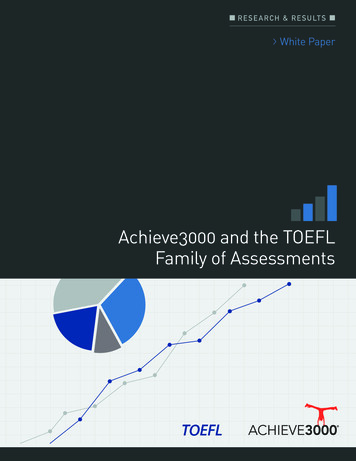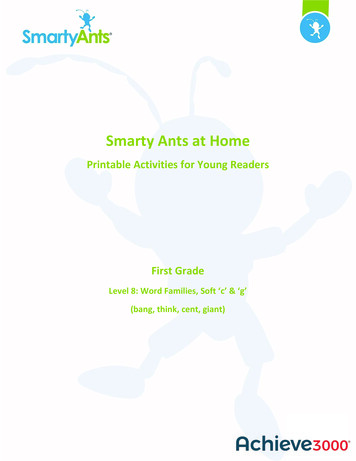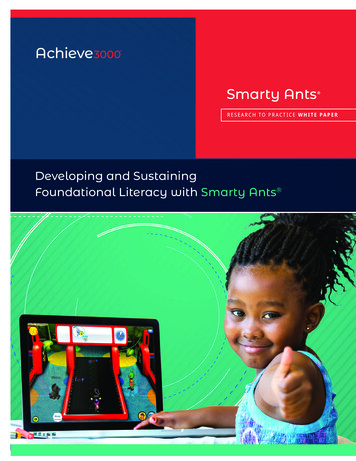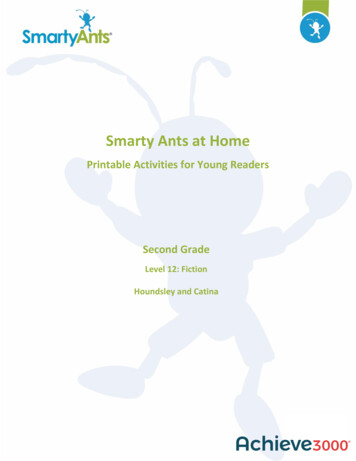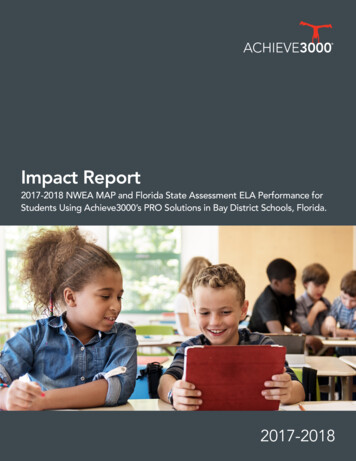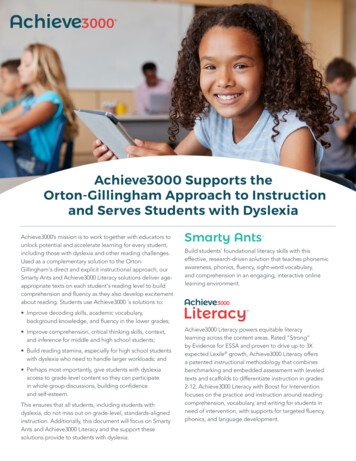
Transcription
Achieve3000 Achieve3000 Supports theOrton-Gillingham Approach to Instructionand Serves Students with DyslexiaAchieve3000’s mission is to work together with educators tounlock potential and accelerate learning for every student,including those with dyslexia and other reading challenges.Used as a complementary solution to the OrtonGillingham's direct and explicit instructional approach, ourSmarty Ants and Achieve3000 Literacy solutions deliver ageappropriate texts on each student's reading level to buildcomprehension and fluency as they also develop excitementabout reading. Students use Achieve3000 's solutions to: I mprove decoding skills, academic vocabulary,background knowledge, and fluency in the lower grades; I mprove comprehension, critical thinking skills, context,and inference for middle and high school students; B uild reading stamina, especially for high school studentswith dyslexia who need to handle larger workloads; and P erhaps most importantly, give students with dyslexiaaccess to grade-level content so they can participatein whole group discussions, building confidenceand self-esteem.This ensures that all students, including students withdyslexia, do not miss out on grade-level, standards-alignedinstruction. Additionally, this document will focus on SmartyAnts and Achieve3000 Literacy and the support thesesolutions provide to students with dyslexia.Smarty Ants Build students' foundational literacy skills with thiseffective, research-driven solution that teaches phonemicawareness, phonics, fluency, sight-word vocabulary,and comprehension in an engaging, interactive onlinelearning environment.Literacy Achieve3000 Literacy powers equitable literacylearning across the content areas. Rated “Strong”by Evidence for ESSA and proven to drive up to 3Xexpected Lexile growth, Achieve3000 Literacy offersa patented instructional methodology that combinesbenchmarking and embedded assessment with leveledtexts and scaffolds to differentiate instruction in grades2-12. Achieve3000 Literacy with Boost for Interventionfocuses on the practice and instruction around readingcomprehension, vocabulary, and writing for students inneed of intervention, with supports for targeted fluency,phonics, and language development.
ORTON-GILLINGHAMREADING STRATEGYPersonalizedTeaching begins with recognizingthe differing needs of learners. Whilethose with dyslexia share similarities,there are differences in their languageneeds. In addition, individuals withdyslexia may possess additionalproblems that complicate learning,such as attention deficit disorder withhyperactivity (ADHD).MultisensoryIt uses all the learning pathways:seeing, hearing, feeling, and awarenessof motion, brought together bythe thinking brain. The instructorengages in multisensory teaching toconvey curricular content in the mostunderstandable way to the student.The teacher also models how thestudent, by using these multiplepathways, can engage in multisensorylearning that results in greater easeand success in learning.HOW ACHIEVE3000 SOLUTIONSADDRESS READING STRATEGYSmarty Ants: The program begins with an initial assessment that identifieseach student’s foundational skill gaps. Based on this information, thesystem automatically generates a learning path that includes thoselessons that are necessary for building the foundational skills for readingcomprehension and writing. Smarty Ants provides students with dyslexiathe opportunity to reinforce and practice what they have learned in a funand engaging format.Achieve3000 Literacy: Students begin by taking the LevelSet assessment to establish their baseline Lexile level. The system thendelivers grade-appropriate lessons differentiated to that Lexile level foreach student. This allows every student in the same class to work on thesame grade-appropriate content and standards-aligned lessons, but at alevel that allows them to successfully build reading strategies, acquire newwords, engage in academic discussion, and communicate ideas throughwriting.Smarty Ants: Graphics, videos, and interactive learning games are availablethroughout the solution to engage all students as they acquire foundationalliteracy skills. All instruction is audio-enabled video and can be returned toat any point while students work through a lesson.Achieve3000 Literacy: Various multisensory tools are available.Teachers have the option to enable or disable these tools, which include: T ext-to-speech and speech-to-text audio with slow, medium, and fastoptions so students can control the speed at which they work Digital highlighter L inks to videos in select lessons to help introduce the topic and providebackground information in a different format that may better conform to astudent’s learning style Audio-support tool and dual-language dictionary for multipleopportunities to hear the pronunciation and see the spelling of words P icture dictionaries to help students make nonlinguistic connections towords, as well as animated songs and videos for further engagementACHIEVE3000.COM
ORTON-GILLINGHAMREADING STRATEGYDiagnostic andprescriptiveAn Orton-Gillingham lesson is bothdiagnostic and prescriptive. It isdiagnostic in the sense that theinstructor continuously monitorsthe verbal, nonverbal, and writtenresponses of the student to identifyand analyze both the student’sproblems and progress. Thisinformation is the basis of planning thenext lesson. That lesson is prescriptivein the sense that it will containinstructional elements that focusupon the resolution of the student’sdifficulties and that build upon thestudent’s progress noted in theprevious lesson.HOW ACHIEVE3000 SOLUTIONSADDRESS READING STRATEGYSmarty Ants: T he system monitors acquisition of specific foundational skills as studentsprogress through each lesson. A dashboard helps teachers track student progress as well as gaps. S tudents automatically receive additional practice when the systemidentifies skill gaps. F or additional support, teachers can use the included program materialsto provide direct instruction.Achieve3000 Literacy: In each lesson, students progress through a patented and provenliteracy routine. S tep 3 of the literacy routine is a standards-aligned activity, which providesdiagnostic information on standards and skills each student has masteredor still needs to develop. A corresponding report provides detailed information to inform teachers’direct instruction based on these gaps. N ew lessons are prescribed to provide students with additional practiceon specific standards and skills.Direct instructionThe teacher presentations employlesson formats which ensure thatthe student approaches the learningexperience understanding what is tobe learned, why it is to be learned, andhow it is to be learned.Smarty Ants: After the initial assessment, an ongoing cycle of assessment and adjustmentbegins as students move through all activities in the program. This providesmore practice, instruction, and guidance as needed while allowing studentsto move quickly through concepts and skills they easily master. E ach new lesson concept is introduced in one or more teaching videos,many of which are interactive. T eachers have access to instructional materials to provide direct instructionin whole-group, small-group, or individual settings. Lesson structure is very clear in Smarty Ants. Students are able to monitortheir progress through each stage of the lesson. The Daily Woof virtual newspaper is delivered to students and announceswhat they accomplished the previous day, and Coach and Flea are alwaysavailable to provide guidance as students move through activities.Achieve3000 Literacy: Best-practice recommendations are provided for a lesson, often usingvisuals (images, maps, and charts) or videos, along with recommendationsfor guiding students through their routines. Instructional supports are available for struggling readers, often withgraphic organizers to promote their comprehension of the content.ACHIEVE3000.COM A bank of reading comprehension and vocabulary lesson plans is availablefor teachers to use in whole- or small-group instruction.
ORTON-GILLINGHAMREADING STRATEGYDirect instruction(cont.)HOW ACHIEVE3000 SOLUTIONSADDRESS READING STRATEGY A chieve3000 Literacy features a wealth of teaching resources to supporta structured vocabulary-acquisition routine. This helps students createshared meaning of words, including nonlinguistic representations of thosewords, a routine for academic discussion, and a guided writing routine. S pecific emphasis is given to text features (such as headers, images, andcaptions) and how they can promote comprehension. S elect lessons include direct-instruction lessons plans around Englishlanguage development and phonics. This instruction—embedded into thestudent’s literacy routine—is targeted to a particular lesson.Systematic phonicsIt uses systematic phonics, stressing thealphabetic principle in the initial stages ofreading development. It takes advantageof the sound/symbol relationshipsinherent in the alphabetic system ofwriting. Spoken words are made up ofindividual speech sounds, and the lettersof written words graphically representthose speech sounds.Applied linguisticsIt draws upon applied linguistics not onlyin the initial decoding and encodingstages of reading and writing but inmore advanced stages dealing withsyllabic, morphemic, syntactic, semantic,and grammatic structures of languageand our writing system. At all times theOrton-Gillingham Approach involves thestudent in integrative practicesthat involve reading, spelling, andwriting together.Smarty Ants provides systematic, spiraled, and explicit instruction toeach student based on individual learning needs and pace, with a goal ofgetting through phonics “first and fast” as the student’s growth permits.The lessons for PreK start with upper- and lowercase letter names andprogress to letter sounds.Automatic notifications in Smarty Ants let teachers know right away whenstudents are ready for the greater challenge of reading comprehension inAchieve3000 Literacy.Phonics instruction in Achieve3000 Literacy with Boost is targeted tospecific skill gaps based on information that teachers learn through SmartyAnts or from the Skills Report.Smarty Ants: Smarty Ants addresses these components based on eachstudent’s “zone of proximal development”—the term coined by pioneeringpsychologist Lev Vygotsky (1978) that refers to the space between tasks a childcan do alone and those requiring help to complete. Students begin with the simplest foundational skills and strategies (e.g.,phonological awareness, and letter names) and progress to more complexconcepts (e.g., blending sounds to decode words, spelling conventions,affixes, and multisyllabic words). Later concepts are built on earlier ones, and students have manyopportunities to apply the knowledge they have accumulated. A large proportion of the words presented in the program are decodablebased on the sound-spelling relationships students have cumulativelymastered in the lessons.This strategic, scaffolded instruction—leading to production of a contextual,phonics-based book—helps students develop a robust vocabulary and buildsthe foundation for writing.Achieve3000 Literacy: Our literacy routine was designed around theintegration of reading and writing. Informal and formal writing is incorporated into every lesson, along with theessential practice of reading strategies and close-reading techniques neededto support evidence-based writing.ACHIEVE3000.COM Students can receive extra scaffolds, delivered at the discretion of the teacher,to guide them through reading and writing.
ORTON-GILLINGHAMREADING STRATEGYSystematic andstructuredIt increases linguistic competenceby stressing language patterns thatdetermine word order and sentencestructure and the meaning of wordsand phrases. It moves beyond thisto recognizing the various forms thatcharacterize the common literary formsemployed by writers.HOW ACHIEVE3000 SOLUTIONSADDRESS READING STRATEGYSmarty Ants: As students progress through the program, the phonicscomponent continually reinforces and builds upon what they have learnedabout the alphabetic principle and basic phonemic awareness. S kill-building activities give students practice in relating sounds tospellings and thereby learning to decode words. If they play all the skill-building games within a lesson, studentsencounter decodable words multiple times. Teaching videos and “word bubbles” strengthen the sound-spellingcues that students are mastering in skill-building games such asTreadmill and Climbing Wall. Once the phonics skills for a particular lesson are taught and mastered,students use what they have learned to build engaging and amusingdecodable stories, which they can print out and read at home. O ver 470 learning songs throughout the program support instructionand facilitate memory of the letter-sound correspondences and otherphonics skills.Sequential,incremental andcumulativeStep by step, learners move from thesimple, well-learned material to thatwhich is more and more complex. Theymove from one step to the next as theymaster each level of language skills.Smarty Ants: A learning path is built for each student after completingthe initial assessment. Lessons are built sequentially and incrementally to ensure that all skillsneeded to complete a level have been mastered. Assessments take place within each lesson to ensure mastery. If gaps continue to be detected, the system cycles back to provideadditional instruction and guided practice. At the end of each level, the system determines whether the student isready to move on to more complex skills.Achieve3000 Literacy: Students receive grade-level content delivered attheir specific Lexile level based on the LevelSet assessment. With up to 12 English and 8 Spanish Lexile levels for every lesson,students receive the version of the lesson that is most precisely matchedto their level. This ensures true equity by meeting the needs of studentsreading below or far below grade level, at grade level, or above or farabove grade level. As students complete the embedded formative assessments, thesystem detects when they are ready for text that is more complex. T ext complexity is continually adjusted based on student performanceusing a proprietary algorithm developed by MetaMetrics , ensuringthat content is always differentiated to each student’s needs. Thisongoing adjustment helps students move to increasingly complex textwhile continuing to practice the same skills.
ORTON-GILLINGHAMREADING STRATEGYContinuousfeedback andpositivereinforcementThe approach provides for a closeteacher-student relationship that buildsself-confidence based on success.HOW ACHIEVE3000 SOLUTIONSADDRESS READING STRATEGYSmarty Ants: Smarty Ants encourages and motivates students to movefrom lesson to lesson and level to level as they learn and strengthenpre-reading and reading skills at their own pace. M otivational tools include virtual games, awards, coins, books, DVDs,ribbons, trophies, the Daily Woof newspaper, Super Ant Animal Rescue,Readers Theatre, recordings, and songs. A s students move through lessons, they are given choice; they can selectthe games they want to play in order to master a particular skill. Each game on the Activity Board allows students to master the sameskill, but the choice allows the program to be personalized to thestudent’s learning temperament and pace. Rewards are scattered throughout the entire student experience tokeep them engaged in learning. For instance, at the end of each levelstudents receive a graduation trophy, which is kept on a shelf in aRewards Room. T eachers have an easy-to-access dashboard that allows them to monitorstudents’ progress and provide additional feedback and instruction asneeded.Achieve3000 Literacy: As students move through the activity questions,they receive feedback. In addition to this ongoing feedback, a numberof tools are designed to motivate students and provide choice, as theelement of choice is central to engagement: B efore students begin to work on lessons, they visit the Career Center,where they are able to read about hundreds of different careers, select atop career, and track their Lexile growth as it pertains to that career goal. As students move through the literacy routine, they earn points andachievements to keep them engaged with the process. T eachers can award points and achievements for noteworthy work thatstudents have completed. T he Lesson Search function allows students to find topics of interest inaddition to lessons assigned by their teacher. Teachers have easy access to all student work and can provide ongoingfeedback—both informal and formal—throughout the independentstudent work, helping learners build self-confidence based on theirsuccesses.ACHIEVE3000.COM
ORTON-GILLINGHAMREADING STRATEGYCognitive approachStudents understand the reasons forwhat they are learning and for thelearning strategies they are employing.Students gain confidence as theydevelop their literacy skills and applynewly gained knowledge.HOW ACHIEVE3000 SOLUTIONSADDRESS READING STRATEGYSmarty Ants: The Story Game Show, which is accessible after completinga variety of games on the Activity Board, is the main site of readingcomprehension activities. A variety of questions asked in a game show format allow the student todemonstrate mastery of a library of stories. Metacognitive thinking strategies are modeled throughout, both by thehost of the show and by the ant friends that the child invites to play alongand react to the story.Achieve3000 Literacy: Once students are ready to transition to readingcomprehension in Achieve3000 Literacy they will move through aninstructional routine that is designed to enhance higher-order criticalthinking skills. I n our patented literacy routine, students start out by expressing anopinion based on experience and prior knowledge in an informal writtenresponse. For some students, academic discussion in which studentscreate a shared understanding of the topic will better serve the studentin forming an opinion statement. F rom there, students read multiple sources of information at their specificLexile level. This is the level at which students can buildreading strategies and close- reading techniques. T ext-to-speech and speech-to-text tools, a highlighting tool, and graphicorganizers are available to support comprehension. A s students read, they look for evidence to help them respond to aThought Question, a written prompt that requires evidence from the text. P oint-of-use supports give students a metacognitive understandingof the routine's steps, what needs to be done within each step, and why. S entence and paragraph frames are provided to supportstruggling writers.ACHIEVE3000.COM
ORTON-GILLINGHAMREADING STRATEGYHOW ACHIEVE3000 SOLUTIONSADDRESS READING STRATEGYEmotionally soundStudents’ feelings about themselvesand about learning are vital. Teachingis directed toward providing theexperience of success. With successcomes increased self-confidenceand motivation.Smarty Ants: Smarty Ants engages younger students in a 3D virtual worldthat motivates them through a game-based environment, encouragingstudents to “play” their way to mastery. Each student’s progress is tracked, and the pace and learning supportis adapted based on that student’s needs. This ensures that the studentsucceeds every step of the way, which instills confidence and pleasure inreading. For students with advanced reading skills or those who quickly grasp newreading concepts, the program accelerates to keep them engaged andchallenged. For students who are struggling, the system slows the pace and increasessupport and scaffolding. As students progress, they begin to discover thejoy of reading.Achieve3000 Literacy: Central to Achieve3000 Literacy is the
Automatic notifications in Smarty Ants let teachers know right away when students are ready for the greater challenge of reading comprehension in Achieve3000 Literacy. Phonics instruction in Achieve3000 Literacy with Boost is targeted to specific skill gaps based on information that teac
